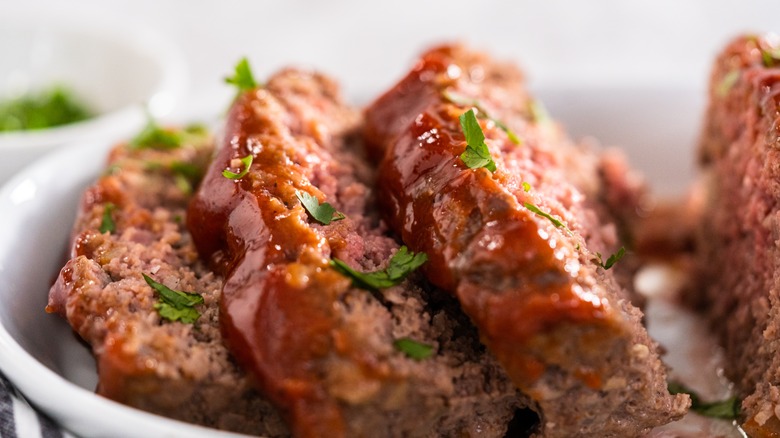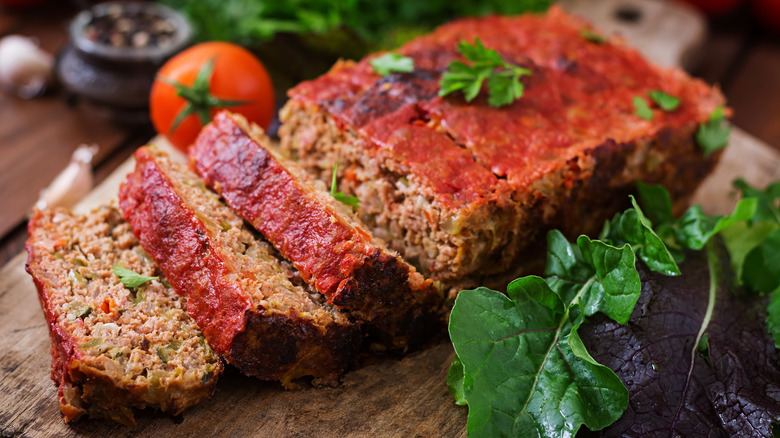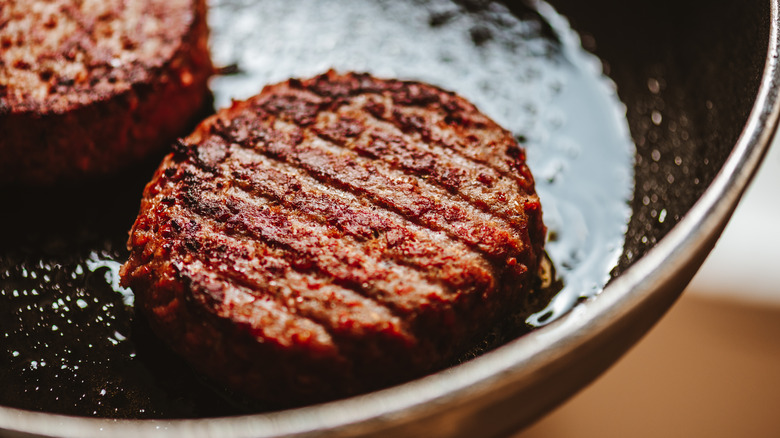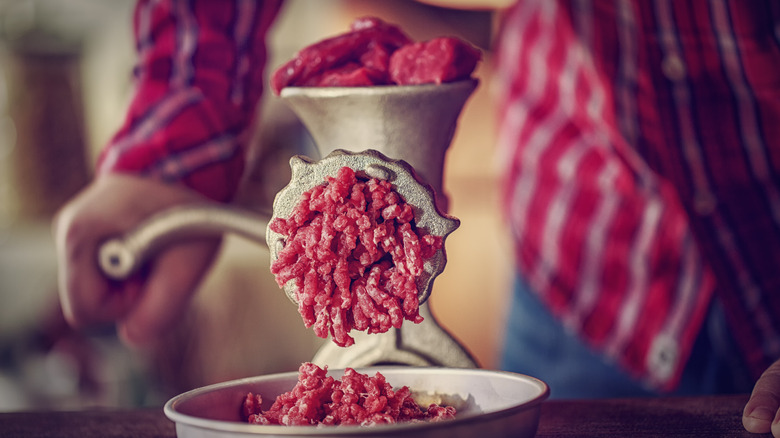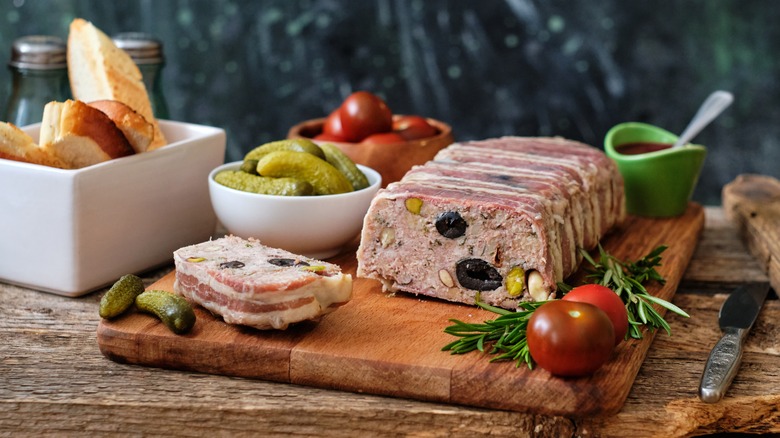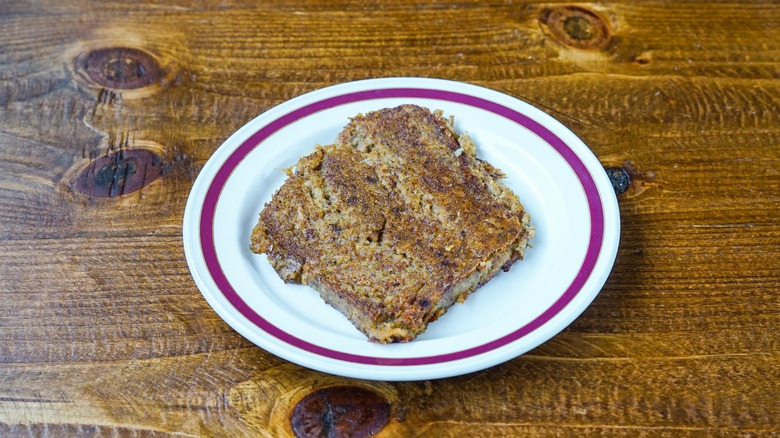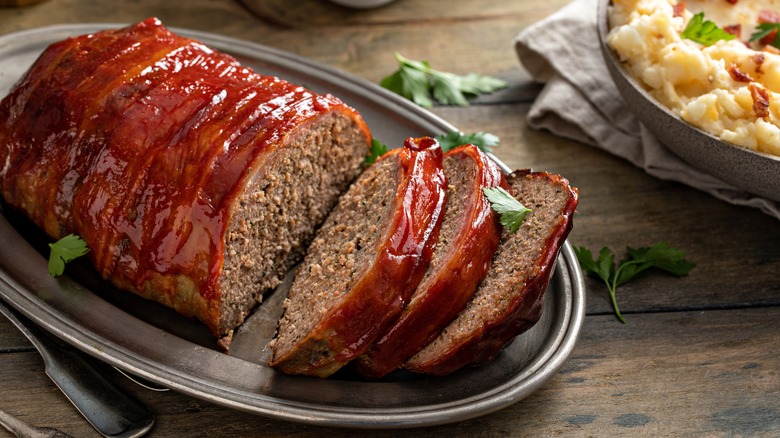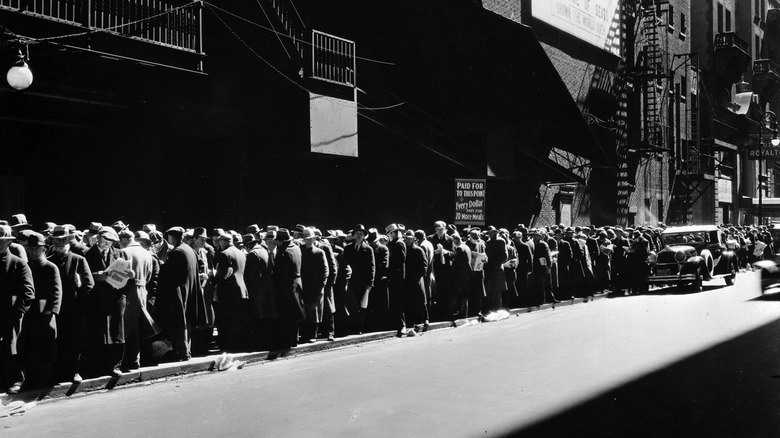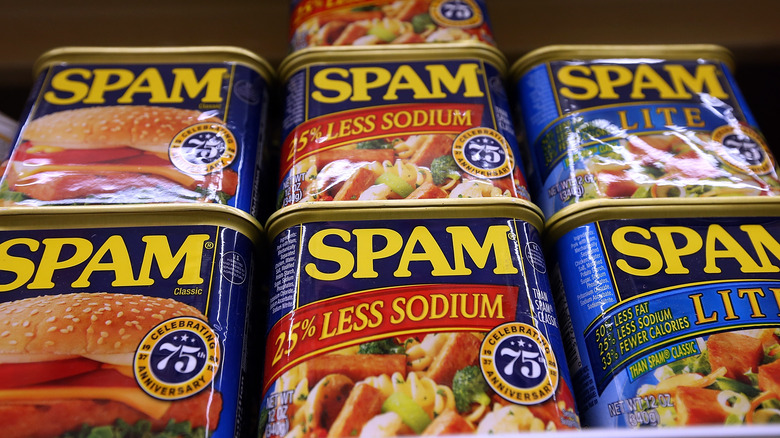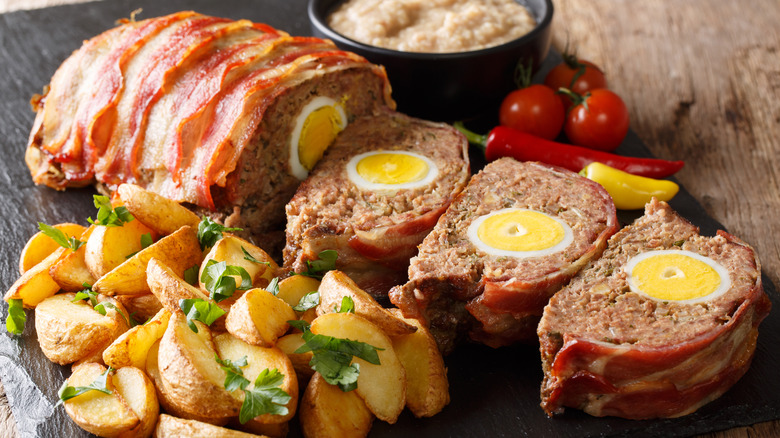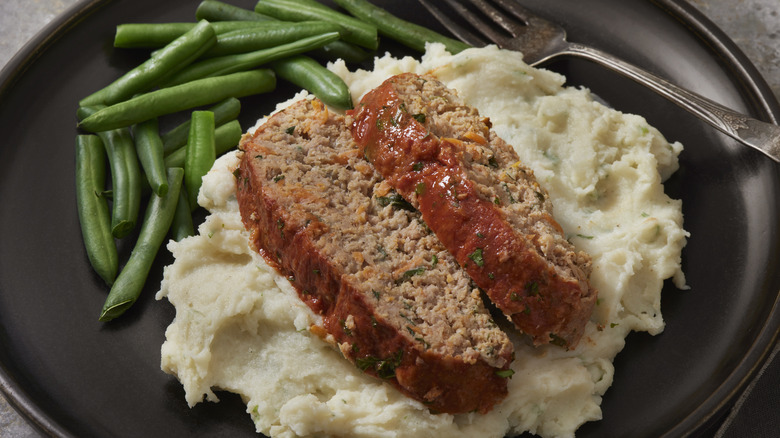The History Of Meatloaf: From Ancient Rome To Comfort Food Classic
Like a bat out of hell, meatloaf — the food, not the musician—has made its way around the world. Though many think of meatloaf as a symbol of American foods and Americana, the dish dates back to long before the "good old days" and isn't actually American at all.
Unlike Native American foods, indigenous to the U.S. and used by Indigenous people and communities for thousands of years, meatloaf is known to have begun its life in Europe long before the U.S. ever existed as a recognized state. It first made it's way stateside thanks to the work of immigrants and soon became woven into the fabric of American food culture.
Like many comfort foods that have also worked to reduce food waste, meatloaf has seen waves and crests of popularity over the years, from the Great Depression to post-war cooking and vegetarian reinventions. Wonderfully versatile and easy to love, meatloaf is a constant source for reinterpretation based on the dietary practices and origins of the cook and whatever food is lingering around in the fridge that might need to be used. Those who still make meatloaf a regular part of their cooking regime might be interested to hear where the family favorite developed its roots.
Meatloaf can be traced all the way back to the 5th century in Rome
Like many other aspects of world history, the Romans have also had a hand in shaping food that has come to represent American comfort cooking, namely the meatloaf. Ancient Romans ate the stuff long before it became a classic diner or Midwestern staple in a very different format.
The collection of ancient Roman cookery, known as De Re Coquinaria or Apicius, documents the meat loaf's first form, dating back to the 4th and 5th century in Rome, where cooks often made it from cooked animal brains and offal. Even since its first notation, meatloaf was always considered a way to make the most out of whatever was available to eat. It is just one of the many foods now much beloved, but it was first used as a way to minimize food waste, which was not an option or practice for most during that time.
Meat-like loaves, known as pastez, turn up in Medieval Europe
As previously mentioned, historians have pinpointed the first meatloaf-like recipe to appear in De Re Coquinaria, a collection of Roman cookery dating back to the 1st century. The recipe, which suggests patties rather than a whole loaf, uses chopped leftover meats, stretched with the use of wine-soaked bread, then flavored with spices and pine nuts. The dish itself was known as "pastez". Pine nuts were a prevalent ingredient at this time, used in dishes and as a source of energy for the Roman military, which may explain how they made their way across the globe.
As the Roman Empire wasn't known for sitting still, so too the dish, alongside the Romans, began to make its way across Europe, finding its way into Germany and Sweden. In Sweden, the dish, known as köttfärslimpa, was served with potatoes, while in Germany, hard, boiled eggs became a common way to stretch out the ingredients. Still made today, köttfärslimpa is served traditionally with potatoes and topped with lingonberry sauce.
The Industrial Revolution made meatloaf what it is today
Today's version of meatloaf has been made possible by several key moments in history. Now considered a classic American comfort food recipe is generally a combination of ground or minced meat, bound together with a mixture of seasoning, breadcrumbs, onions, and an optional addition of ketchup or tomato paste.
Thanks to the industrial revolution and the invention of the meat grinder, meatloaf transformed its chunky textures of the past into a smoother, more homogenous form. Prior to this shift, which began in Europe in the late 18th century, the meat would be minced by hand, making it an incredibly laborious task and one which many avoided. As the meat grinder became an item in every butcher shop, the workload of the home cook eased significantly.
Another component that has become a part of the American staple is ketchup, which got its start in China. The condiment, now a much-loved glaze onto meatloaf, resulted from a fermented fish sauce commonly available in Southern China. The sauce, known as "ge-thcup" or "koe-cheup," traveled across trade routes to Indonesia and the Philippines, where they eventually intermingled with the British and eventually tomatoes from South America in the 1500s. The rest, as they say, is history.
By the 1600s, French cuisine embraced a meatloaf-like dish known as terrine
Think all French food is fancy and only for the well-mannered elite? Think again! Even the French love meatloaf; well, their version of it.
What we now know as pâté had humble rustic beginnings around the the1600s, as 'pâté de campagne' or country pate. This pate, made of coarsely chopped meats, was then encased in a thick layer of rendered fat, known as a terrine, and designed with a purpose. The terrine was born in rural, domestic kitchens in France to preserve as much of the meat as possible. Meats, including veal, pork, chicken, and rabbit, were finely chopped, creating a coarse texture bound together through fats and gelatine. Later the texture was refined, thanks to the presence of the meat grinder. However, pâté de campagne often retains its chunkier, coarser texture.
Like meatloaf, which benefits from a dollop of mustard or the acidity of ketchup, pate also benefits from a dose of spice or acidity, either from a mustard, pickle, or chutney to help add balance to the meaty, rich food.
1700s meatloaf, known as scrapple, becomes a breakfast favorite of the Pennsylvania Dutch
Eventually, meatloaf made its way to the United States alongside a community that became known as the Pennsylvania Dutch, with ancestry in both Dutch and German heritage. As with traveling peoples, so too does the cuisine, a dish which eventually became known as 'scrapple' took root during the influx of immigrants from Germany and Switzerland to the southeastern region of Pennsylvania.
Drawing from German and Dutch black puddings, then reinterpreting them, the scrapple reflected new tastes, excluding any use of blood or wheat and replacing them with American-grown grains such as corn and buckwheat. The purpose of the scrapple, however, remained the same. It was a way to use any edible cuts of meat, stretching them with grains and making them more palatable and tempting with whatever spices and herbs were on hand.
The scrapple is still a celebrated part of the Pennsylvania Dutch community. Popularly served as breakfast meat or fried until crispy and tucked into a sandwich, it's used much like sausage or bacon. There are also celebrations like the Bridgeville Apple-Scrapple Festival, taking place annually and includes scrapple baking contests, a 'Scrapple Sling,' and more.
By the late 1800s, meatloaf is eaten for breakfast in New England
Having cemented itself within Pennsylvania Dutch culture, it didn't take much time for the presence of meatloaf to grow elsewhere in America. The first American-born meatloaf recipe dating back to around the 1870s, according to food historian Andrew Smith, suggested home cooks viewed the dish as a means for using up leftovers. In U.S. regions like New England, not so far away from the German/Dutch community residing in Pennsylvania, leftover meat was primarily beef. It was a culinary practice to slaughter a cow just before winter, sustaining New Englanders throughout the colder months. Meatloaf seemed like a natural progression, not to mention a hearty meal of sustenance at this time of year.
Like the Pennsylvania Dutch, this was not dinnertime fare but rather in place of a bowl of cereal or anything else we might consider standard breakfast foods. New Englanders changed the recipe from the traditional cornmeal, adding instead slices of bread soaked in milk as a binding to the chopped-up beef. As the meat packing industry expanded and changed, incorporating machinery like industrial meat grinders and churning out pre-ground beef, so too did the meatloaf itself continues to evolve, becoming a catch-all not just for leftover roasted meats but spices.
The Great Depression increases meatloaf's popularity
Unsurprisingly, the Great Depression has had a strong hand in shaping American food culture, from the creation of what we now know as the soup kitchen, which helped provide a hot meal to those in need, to the rise in industrial-sized food corporations. Many foods still popular today came into the public domain due to necessity; a combination of tight budgets, food rations, and lack of availability inspired a need for creativity adopted in the kitchen and an attitude of creating as little food waste as possible in the kitchen.
Foods like buttermilk, a byproduct of butter-making, shelf-stable items like Spam and Kraft Macaroni & Cheese, and resourceful uses of leftovers like soups and meatloaf were just a few ways in which households could stretch what little they had and feed their families. Perishable, high-value items, like meat, could be extended further by combining ground meat, largely beef, with easier-to-come-by ingredients like bread crumbs, which home cooks could make from stale bread. Served with other starchy fillers like potatoes, it was a rib-sticking comfort meal that used whatever was on hand, from spices to stale ends of bread.
After the World Wars, Americans get creative with meatloaves
By WWII, meatloaf had taken on a whole new symbolism, a badge of honor and identity rooted in wartime creative innovation and the ability to make do. Foods from canned soups to cornflakes were mixed into the loaf, also reflecting the oncoming trend of convenience foods that was beginning to form.
By the 1950s, meatloaf became a symbol of Americana and a key feature of a doting happy housewife. Brands like Betty Crocker, marketed to white, middle-class women of the suburbs, began to dominate food culture, selling convenience foods that were supposed to deliver effortless, reliable dinners alongside the post-war American dream. A 1960 publication, "365 Ways to Cook Hamburger," boasted an eye-watering 70 recipes for the meat-based loaf alone, including just about everything, including a pineapple meatloaf. Good Housekeeping was also on the bandwagon, printing recipes for Mushroom-Stuffed Meatloaf and a Spicy Peach Loaf, alongside recipes where mashed potatoes doubled as icing, glazed over the loaf, then baked like a crust.
Meatloaf begins trending in restaurants in the early aughts
Meatloaf has remained in the fold of American cooking, with boosts and dips in popularity. It has become a classic on many diner menus, alongside a pot roast, each served with copious amounts of mashed potatoes — a tribute to the comforts of home cooking. In the late '90s and into the early aughts, meatloaf made yet another comeback in popularity, not just in the domestic kitchen or on the diner menu but in restaurants of all kinds. Andrew Smith told NBC News back in 2005, meatloaf had "graduated from diner food into restaurant food." as chefs like Gavin McMichael were adding it to their restaurant menu alongside upscale, fine foods like foie gras. In 2006 McMichael was serving up his version made with a mixture of pork and beef that included flavors like roasted tomato puree, poblano chilies, and panko breadcrumbs, serving it with mashed potatoes and creamed corn for some throwback nostalgia.
In the early 2000s, comfort foods like chicken pot pies, meatloaf, and other recipes steeped in Americana began to trend, a way for Americans to eat their feelings following the 9/11 terrorist attacks and feelings of uncertainty and sorrow it brought. Many chefs began adding these foods to their menus. While trends started to move away from meat shortly after that, with authors like Michael Pollen becoming a strong voice in the future of food, the meatloaf never fully disappeared.
Meatloaf remains a classic comfort food for many
Though the popularity of meat, and beef in particular, has begun to wane due to the necessity and demand for vegetarian or more earth-conscious ingredients, the comforting power of a classic meatloaf recipe has never really wavered. It still delivers a sense of comfort and safety while also stretching meat and using other vegetables, herbs, or spices that may have seen better days.
With the rise of vegetarian alternatives, it is now more possible than ever to substitute a vegetarian ingredient for ground beef for those looking for the comforting power of meatloaf but without the 'meat' part.
Have it warm with a glaze of ketchup or barbecue sauce, add hard-boiled eggs to the center, smother it in a mushroom gravy, green chile sauce, lingonberry, and cream sauce, smoke, pipe with mashed potatoes or cold, and between two slices of bread. There are as many ways to serve meatloaf as there are countries in the world, maybe even more.
